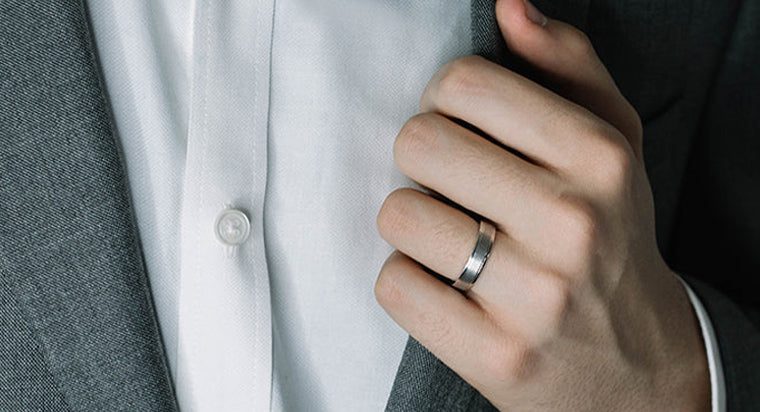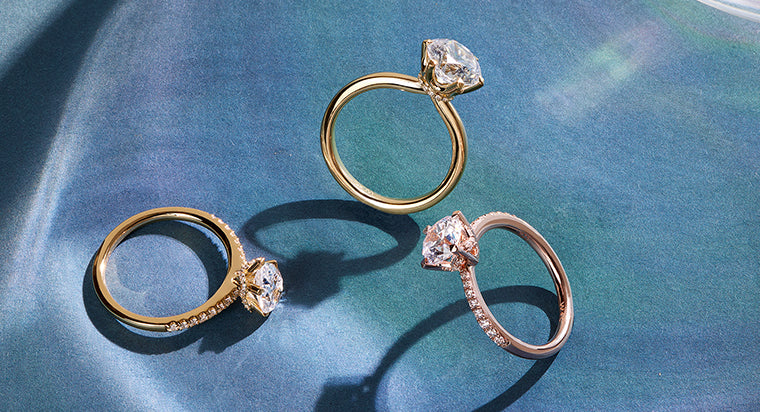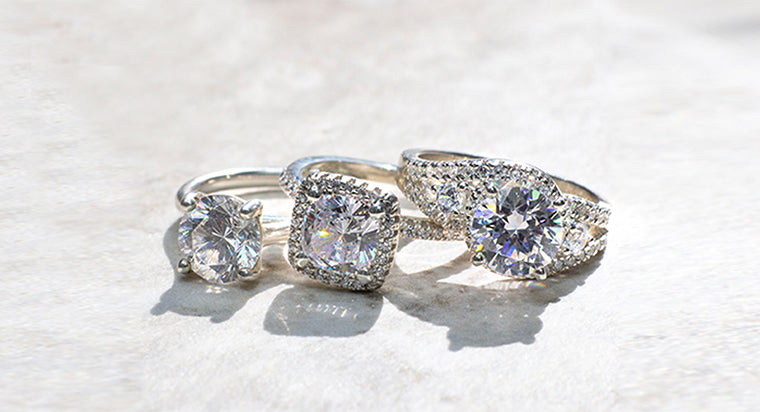14kt vs 18kt Gold Engagement Rings

The engaged couple has picked out the stone, the band, the cut, so what comes next? Originally, it probably seemed like an easy task to pick out an engagement ring, but for every ring there are decisions, decisions, decisions. Before completing the purchase, a couple must consider the type of gold. There is a big question surrounding whether 14 KT or 18 KT gold is better for a wedding ring.
TABLE OF CONTENTS
What is a Karat?
Before beginning, it is important to know what karats even mean. A karat is simply a term of measurement for the purity of gold. To give a frame of reference, 24 KT gold is pure gold. Although it is desirable to have “real” gold, pure gold is too soft to be used in its purest form and must, therefore, be combined with other metals to make it hard enough to be used for jewelry. When thinking about karats and their closeness to pure gold, 14 KT gold is 58% pure gold, while 18 KT is 75% pure gold. Since it is closer to pure gold, 18 KT gold will most certainly cost more than 14 KT gold. However, since it contains more gold than 14 KT, the 18 KT gold will make for a heavier ring.
Strength-wise, 14 KT is much stronger than 18 KT due to the heavier mixture of metal alloys. Therefore, this strength is important in very detailed rings. For example, having strong metal for the prongs will keep the diamonds in place better than prongs of a weaker metal.
Durability-wise, 18 KT gold is much more likely to get scratched than14 KT gold because it is closer to the softness of pure gold. With this in mind, one will have to polish an 18 KT gold ring much more often than a 14 KT ring.
For vintage lovers, 18 KT gold might be a more popular choice because this particular metal scratches in a way that ensures a patina. If a ring has a more rustic flair to it, this patina might be especially desirable.
14 KT vs. 18 KT Yellow Gold
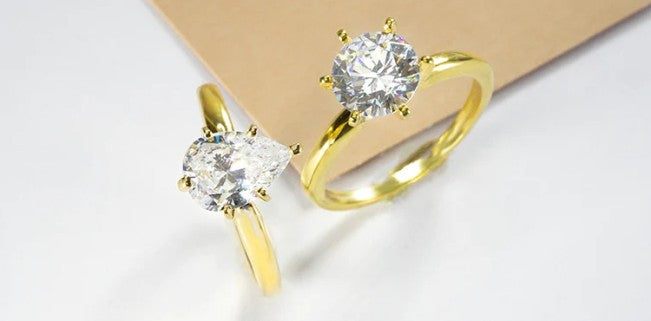
Yellow gold has a warm, rich look that's resurging in popularity for engagement rings. Extremely versatile, it lends itself to a number of styles — but here's your first choice: 14k or 18k yellow gold?
The difference between 14k and 18k yellow gold is the amount of gold each contains. 18k yellow gold contains 75 percent gold and 25 percent alloyed metals, and 14k yellow gold contains 58 percent gold and 42 percent alloys. The proportion causes a slight difference in appearance and price.
Can you See the Difference Between 14k and 18k Yellow Gold?
Yes, the two types are beautifully distinct. 18k yellow gold is a rich yellow color, while 14k looks whiter because it contains more alloy. But the difference in appearance can also depend on accent diamonds — the more you have, the less focal the metal will be.
What's the Price Difference Between 14k and 18k Yellow Gold?
There's a slight price difference between 14k and 18k yellow gold: 18k will cost a bit more, because it contains more actual gold than 14k.
The price difference varies from style to style (you can easily compare on our product pages). The more metal used in the setting, the more the price difference will be. In smaller, petite rings the difference can hover around $90, but for styles that use a lot of metal detailing and a thick band, the difference can climb above $200.
Is There a Difference in Durability?
Yes, and that's also dependent on the amount of gold in each. 18k golds are softer than 14k, because they include more actual gold, which is a relatively soft metal. Yellow gold also isn't coated in anything, like white gold is with rhodium, so it doesn't gain any additional strength that way.
Is 14k or 18k Yellow Gold Better?
That totally depends on your personal preference! If you have a particularly active lifestyle or work a lot with your hands, you might want to opt for 14k gold for its higher durability. How yellow you like your yellow gold to be might also influence your decision — but remember that if you choose an engagement ring style with several accent diamonds, that could change the ring's overall effect. Considering durability and look, and aiming for a balance of those two factors according to your personal taste and priorities, is probably the best way to decide.
14KT Yellow Gold Ring

Ridged Pave Diamond Engagement Ring
This incredible ring is made out of 14kt yellow gold. It features 0.10 carats of pave set accent diamonds. These tiny diamonds are ridged onto the band, and they are slightly elevated. This accents the classic solitaire setting and adds a nice sparkle to it. The combination of 14kt yellow gold with the round center diamond stone (and accent diamonds as well) is breathtaking.
18KT Yellow Gold Ring
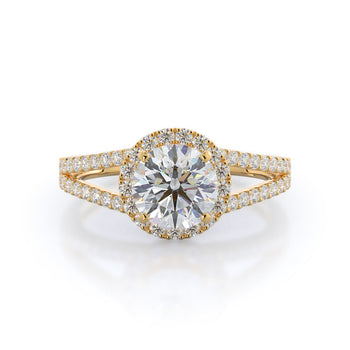
Rising Split Shank Halo Diamond Engagement Ring
The metal shares the stage beautifully with your center diamond in this stunning engagement ring. This ring uses a special split shank setting featuring two different smaller bands for maximum visual impact. The two outside bands are covered in delicate milgrain metal work, or tiny globes of gorgeous, glowing 18k yellow gold.
14 KT vs. 18 KT White Gold

White gold is the MVP of engagement rings, the most requested metal by far. It's easy to see why: It's classic and versatile, highlights any style setting and blends exceptionally well with other jewelry. But when shopping for white gold, you do have a choice to make. So what side are you on: 14k vs 18k white gold?
The difference between 14k and 18k white gold is the amount of gold each contains. 18k white gold contains 75 percent white gold and 25 percent alloyed metals, and 14k white gold contains 58 percent gold and 42 percent alloys. The proportion causes a slight difference in appearance and price.
Can you See the Difference Between 14k and 18k White Gold?
This depends on how sharp your eyes are! There's a big difference between 14 and 18k gold when it's yellow or rose gold, but white gold is harder to detect. That's because both 14k and 18k white gold are dipped in rhodium (a silvery white metal similar to platinum) to give them durability and a bright white appearance. If you look closely at the rings side by side, you'll be able to see that 14k tends to look whiter than 18k. But it's difficult to tell from a distance or when there's no comparison close by.

What's the Price Difference Between 14k and 18k White Gold?
There is a bit of a price difference between 14 and 18k. An 18k white gold ring will cost slightly more, because it contains more actual gold than its 14k counterpart.
The price difference varies from style to style (you can easily compare on our product pages). The more metal used in the setting, the more the price difference will be. For example: In this small ring, there's a $90 price difference in 14k vs 18k white gold. This thicker ring has a $240 price difference in 14k vs 18k.
Is There a Difference in Durability?
Not really. In general, 18k golds are softer than 14k, because they include more actual gold, which is soft. But both varieties of white gold are "dipped" in a rhodium plating, which gives them both nearly equal durability.
But it's worth noting that it's important to get your white gold ring re-dipped every so often to preserve its beauty and durability, no matter which option you select. (Read more about ring dipping, and how often you should get it done.) So technically, 14k white gold is stronger. But the difference isn't substantial.
Is 14k or 18k White Gold Better?
That depends on your personal preference! But in some cases, 18k white gold can be better for people with an allergy to alloyed metals, because 14k white gold contains more of them.
14KT White Gold Ring
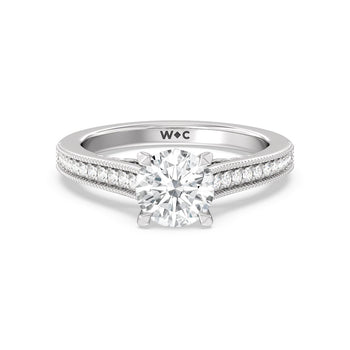
Petal Hidden Accent Milgrain Engagement Ring
This stunning engagement ring is made out of 14kt white gold. There is so much delicate detail and beauty in this white gold engagement ring. It features a hidden petal shaped diamond accent, paired with detailed milgrain beadwork on both sides of the ring. The ring is extremely stylish and elegant. It is also very sparkly, which is due to the pave diamonds that are on it.
18KT White Gold Ring

Classic Hidden Halo Engagement Ring
This classic engagement ring is made out of 18kt white gold. It has a very traditional halo which is a hidden halo, meaning it's underneath the center diamond stone, not at the same level as it. The entire band is covered with sparkling pave set diamonds that go all the way from one end to the other.
14 KT vs. 18 KT Rose Gold
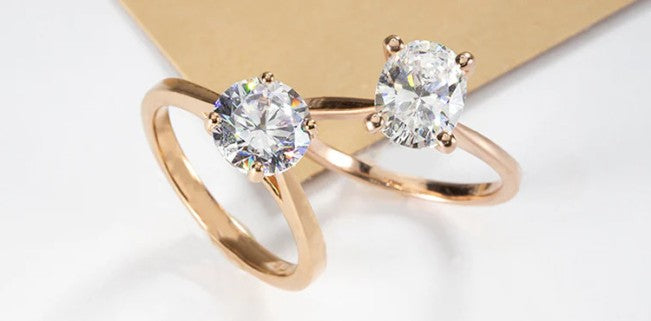
Rose gold was initially dismissed as a good metal for diamond engagement rings because of its trendiness. However, the metal proved it has staying power — thanks to its pretty pink hue — and more brides-to-be are opting for it over traditional metals like white gold and platinum.
One question you'll have to answer when you opt for rose gold is whether you want 14k or 18k. But, what exactly does that mean? Let's break down the differences in 14k vs 18k rose gold — and what it means for you.
14k vs 18k Rose Gold: The Visual Difference
While both 14k and 18k rose gold will have a rosy hue, the brightness will depend on which you pick. Rose gold that is 14k will have a brighter - and more pinkish — tint to it than 18k rose gold, which will have softer, champagne color.
The reason: It all comes down to what's inside.
The “k” in 14k and 18k is used to describe its purity (out of a possible 24). Pure gold is 24k, meaning that it's not mixed with anything else. On the other hand, 1k means that it contains 1 part gold, while the rest of the metal is comprised of other allows.
How does that translate to 14k vs 18k rose gold? With 14k gold, it contains 14/24 gold. This means the actual rose gold is about 60 percent gold, with the other 40 percent being other metal allows like copper (which gives it the pink hue it's known for).
So, does that mean 18k rose gold has 18 parts of gold? Correct! Seventy-five percent of 18k rose gold is gold, while the rest is copper and other alloys. It won't be as bright as 14k rose gold because it contains less copper, which is the main element that gives this precious metal its rosy hue.
14k vs 18k Rose Gold: The Difference in Durability
So, you should always choose the option with more gold, right?
Maybe, but it all depends on what you want in the metal.
Gold is naturally a softer metal — and the higher in quality you go, the softer it will be. The same goes for rose gold: 14k is stronger because it's more copper alloy, which is harder than gold. On the other hand, 18k rose gold will scratch far more easily because it contains more real gold.
Does 14k or 18k Rose Gold Tarnish?
Good news! You won't have to worry about tarnish when deciding between 14k or 18k rose gold, because it's pretty durable. Rose gold will, however, still collect dirt and dust over time — so don't forget to keep it clean.
14k vs 18k Rose Gold: The Price Difference
Here's the thing: Rose gold might have a pink hue, but it's still made with gold and the price will reflect that of real gold.
As a general rule, 18k rose gold will be more expensive because it's made with more true gold. But the actual price of 14k vs 18k rose gold will depend on the setting and how much of the particular metal is used. For example, a micropave band will be far smaller than a wide band featuring metal work like filigree or milgrain — and the price will reflect that.
14KT Rose Gold Ring

Cascading Channel Set Diamond Engagement Ring
This is the perfect ring for those who are into channel set diamond rings, with rose cold. It is made out of 14kt rose gold and the center diamond stone can be round, princess, radiant, cushion, Asscher, or emerald cut. If you prefer pear-shaped or marquise cuts it can be that as well. It features a subtle amount of 0.10 carats that flow upwards to the center diamond.
18KT Rose Gold Ring

Knife Edge Milgrain Diamond Engagement Ring
This gorgeous knife edge milgrain diamond engagement ring pairs wonderfully with 18kt rose gold. It has a vintage look to it, from the vintage-inspired metal milgrain accents. It also has a knife edge shape, hence the name. This ring combines traditional and modern perfectly, it has a wonderful balance between the two. Additionally, the stunning engagement ring is finished with 0.27 carats of round accent diamonds that make the center round diamond stone stand out even more.
How to Pick the Right Rose Gold for you
Still not sure which type of rose gold is right for your diamond engagement ring? Let our expert gemologists help. Just fill out a few simple questions and they'll pick out a few options that fit your needs — and budget. From there, you can use With Clarity's home preview program to test out rings (and feel the metal for yourself) before you decide.
How To Choose a Metal
The color of the gold does not play a significant effect on the price of the ring; the value is determined more through karat than it is by color.
For the customers who have allergies to certain metals, like nickel, an 18 KT gold ring will be much less likely to spawn an allergic reaction than its less pure 14 KT counterpart. However, the allergy aspect is only a concern with yellow gold. The white gold rings are coated with rhodium, and therefore, the actual gold alloy never comes into contact with the wearer's skin.

In the US, 14 KT gold tends to be the more popular choice for engagement rings, but in Europe and Asia, the buyers typically prefer 18 KT gold. Ultimately, the better choice lies within the wants and needs of the wearer as there are many factors affected by the choice in gold. Whether a buyer chooses 14 KT or 18 KT depends on their lifestyle, their budget, and their stylistic choices. It is just one more way in which couples can customize their engagement!
Metal Pros & Cons
White Gold
Pros: Generally more affordable than other types of metal. If you spend less on the metal, you can invest more money into a higher quality diamond or gemstone. White gold is tougher and stronger than yellow, or pure gold. It is also harder to scratch compared to metals such as platinum. It has a beautiful appearance and it can highlight the brilliance of diamonds.
Cons: White gold contains nickel, which many people are allergic to. If you have an allergic reaction to nickel, you can experience itchiness, discoloration, and swelling. Chemical sensitivity can be an issue with white gold, especially when in areas that contain chlorine like public pools or hot tubs. This could make the metal discolored.
Yellow Gold
Pros: Yellow gold engagement rings look beautiful on people who have olive or darker skin tones due to the nice contrast it provides. It's a very popular and traditional metal choice. It's the most malleable metal, meaning it's the easiest for jewelers to work with.
Cons: Yellow gold, especially yellow gold that's high-karat, is more likely to be scratched or dented than other metals. It should be cleaned regularly and polished more often than other rings. Doesn't look as impressive on people who have pale and fair skin tones.
Rose Gold
Pros: Provides a unique and romantic look to any engagement ring. Looks amazing in vintage-inspired engagement rings. Rose gold is the strongest out of the three golds. This is due to the copper that it contains because copper is very sturdy.
Cons: The copper in rose gold can cause allergic reactions to those who have sensitive skin. Rose gold cannot be called a hypoallergenic metal.
Average Ring Prices
For solitaire engagement rings when it comes to 14kt or 18kt gold.
| Metal Type | Classic Six Prong Solitaire | Petite Solitaire | Knife Edge Solitaire | Classic Cathedral Solitaire |
|---|---|---|---|---|
| 14kt White Gold | $290 | $310 | $340 | $360 |
| 18kt White Gold | $390 | $420 | $570 | $560 |
FAQs
How to choose between 14kt and 18kt for an engagement ring?
How much gold does 18kt contain?
Does 18kt gold cost more than 14kt gold?
Is a 14kt white gold engagement ring more durable than an 18 kt white gold engagement ring?
Can you tell the difference between 14kt rose gold and 18kt rose gold?

